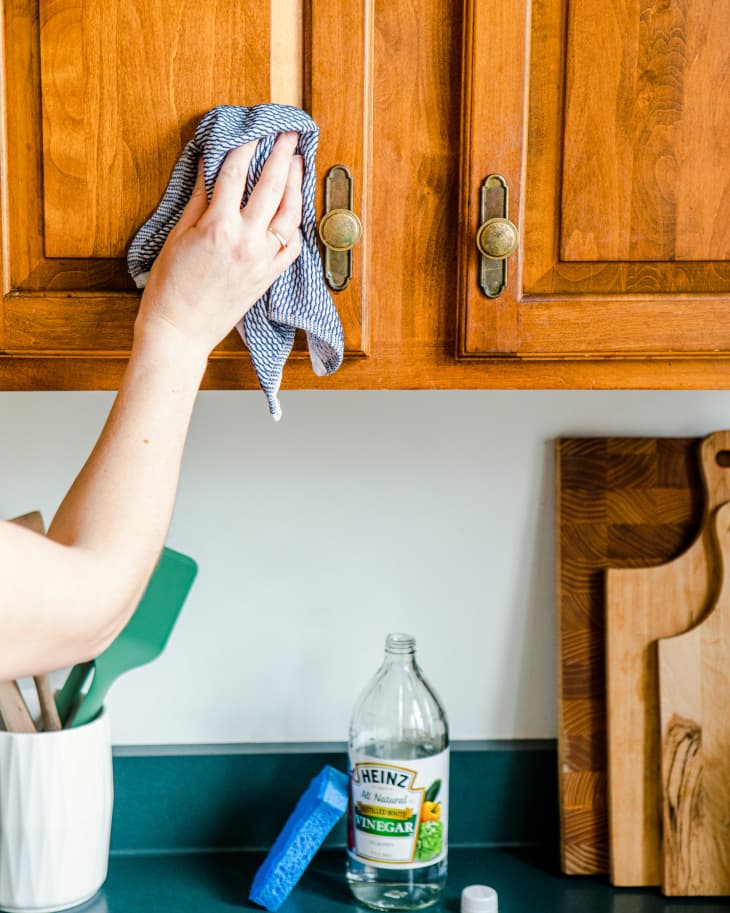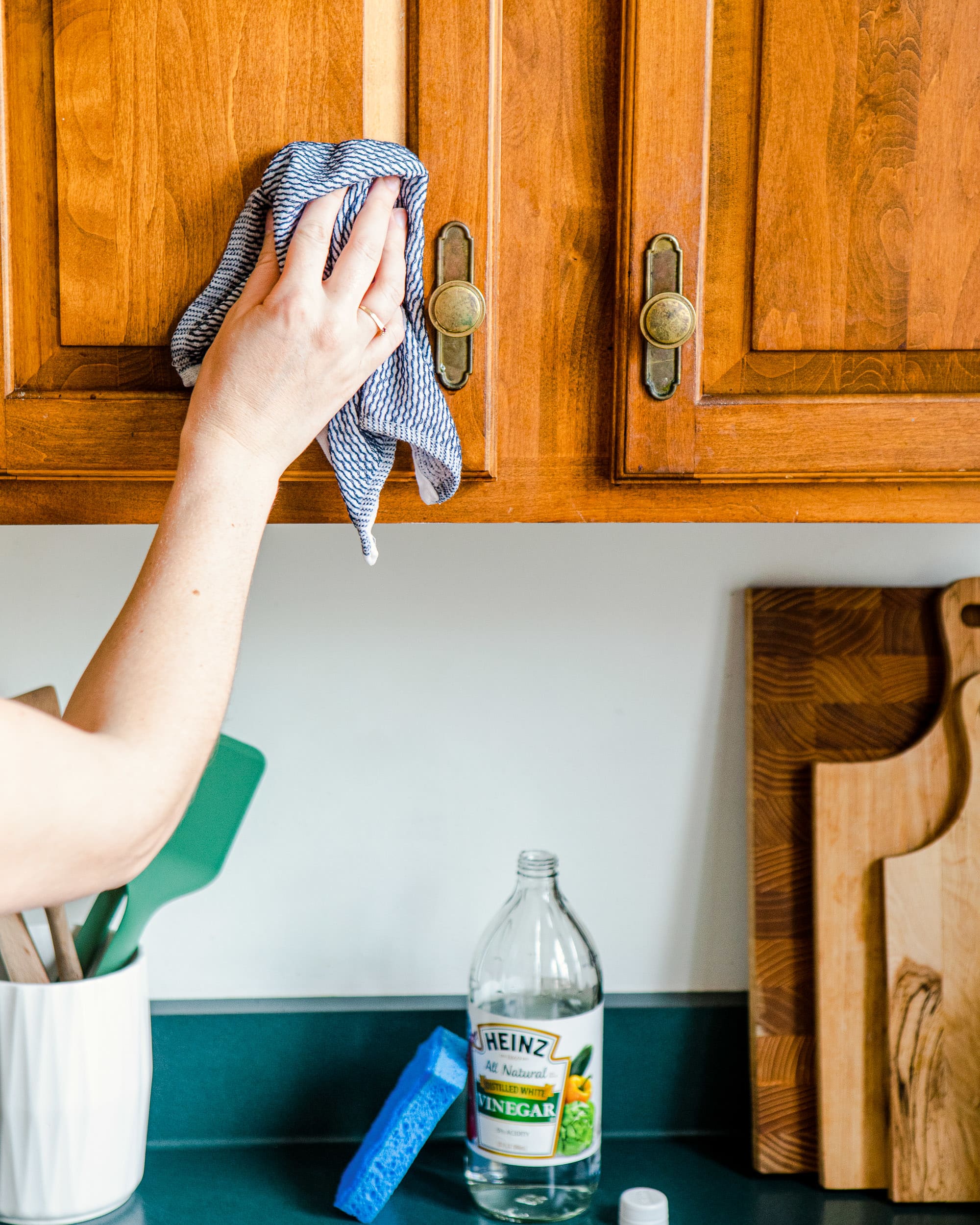Are your kitchen cabinets looking a little worse for wear? You’re not alone.
Every day, your cabinets endure spills, splatters, and fingerprints. Over time, these can make even the most beautiful kitchen feel tired and dirty. But here’s the good news: finding the right cleaner can make a world of difference. Imagine the satisfaction of seeing your cabinets shine like new again, effortlessly enhancing the heart of your home.
Dive into this guide as we uncover what makes a cleaner truly effective for kitchen cabinets, helping you choose the best option to keep your kitchen fresh and inviting. Ready to reclaim that sparkle? Let’s get started!
Types Of Cabinet Surfaces
Kitchen cabinets come in various materials and finishes, each requiring a unique cleaning approach. Using the right cleaner not only ensures a spotless kitchen but also extends the life of your cabinets. Let’s explore the types of cabinet surfaces and how to keep them looking their best.
Wood Cabinets
Wood cabinets exude a timeless charm, but they can be sensitive to moisture and harsh chemicals. A mild dish soap mixed with warm water works wonders for regular cleaning. For deeper cleaning, you might try a vinegar and water solution, but always test on a small area first to avoid damaging the finish.
Remember to dry the cabinets with a soft cloth immediately after cleaning to prevent water spots. Have you ever noticed how a bit of olive oil can restore shine to wood surfaces? Just a dab can go a long way in maintaining that rich, warm look.
Laminate Cabinets
Laminate cabinets are a popular choice due to their affordability and resilience. They are less porous than wood, making them easier to clean with just a damp cloth and a mild cleaner. Avoid abrasive scrubbers that can scratch the surface.
Have you ever thought about using baking soda for tough stains? Mix it with water to form a paste, apply gently, and watch the magic happen. It’s an eco-friendly alternative that’s kind to your cabinets and the planet.
Painted Cabinets
Painted cabinets offer a splash of color and personality to your kitchen. However, they require gentle care to avoid chipping. A simple solution of dish soap and warm water is ideal for everyday cleaning.
Always be cautious with cleaning products that contain alcohol or ammonia, as they can strip the paint. If you’ve ever worried about preserving your cabinet’s color, using a microfiber cloth can help maintain the finish without scratching.
Metal Cabinets
Metal cabinets bring a modern edge to your kitchen but can show fingerprints and smudges easily. A mix of vinegar and water can effectively clean and shine these surfaces. Just like with wood, always dry the metal afterward to prevent water marks.
Have you tried using a bit of baby oil to polish metal cabinets? It can help repel future smudges and keep your kitchen looking sleek. What’s your favorite hack for keeping metal cabinets spotless?
Choosing the right cleaner for your kitchen cabinets doesn’t have to be a daunting task. With a little knowledge about the different surfaces, you can keep your cabinets looking pristine and prolong their life. So, what’s your next cleaning project?
Essential Cleaning Ingredients
Kitchen cabinets often gather grime, grease, and stains over time. Keeping them clean is essential for maintaining a fresh and inviting kitchen space. Knowing which cleaning ingredients work best can make the task easier. Let’s explore some essential cleaning ingredients for your kitchen cabinets.
Natural Cleaners
Natural cleaners are safe for you and the environment. Vinegar is a popular choice. Its acidity breaks down grease and grime effectively. Mix equal parts vinegar and water for a simple solution. Baking soda is another great option. It gently scrubs away stains without scratching surfaces. Combine it with water to form a paste. Lemon juice is excellent for cutting through grease. Plus, it leaves a fresh scent.
Chemical Cleaners
Chemical cleaners offer powerful cleaning action. They can tackle tough stains and built-up grease. Look for multi-surface kitchen cleaners. They are designed for cabinets. Ensure they are non-abrasive to protect finishes. Degreasers are another effective choice. They are formulated to dissolve stubborn grease. Always follow the manufacturer’s instructions for safe use.
Homemade Cleaning Solutions
Are you tired of chemical-laden cleaners and want to try something natural for your kitchen cabinets? Homemade cleaning solutions can be both effective and environmentally friendly. Not only are they easy to make, but they also keep your cabinets looking spotless without the harsh smells or risks of commercial cleaners.
Imagine opening your cabinet doors and smelling the fresh scent of lemon or feeling assured by the simplicity of vinegar and baking soda. These solutions are not just practical; they’re a way to bring a little bit of nature into your cleaning routine.
Let’s dive into some simple yet powerful homemade solutions that you can try today.
Vinegar And Baking Soda Mix
Vinegar and baking soda are a dynamic duo in the cleaning world. Mixing them can create a paste that tackles dirt and grime with ease. Simply combine equal parts vinegar and baking soda to form a thick paste.
Use a sponge or cloth to apply the mixture to your cabinets. Scrub gently to avoid damaging the finish. You’ll be amazed at how easily stains lift away.
Did you know this mix can also deodorize? Vinegar’s natural acidity neutralizes odors, leaving your kitchen smelling fresh. Have you tried using this on your cabinets yet?
Lemon Juice And Olive Oil Blend
Lemon juice and olive oil are more than just salad dressing ingredients. They make an excellent cleaner and polisher for wood cabinets. Mix one part lemon juice with two parts olive oil for a perfect shine.
This blend not only cleans but also nourishes the wood, giving your cabinets a healthy glow. It’s like giving them a spa treatment! Rub the mixture onto the cabinets using a soft cloth, and watch them sparkle.
Plus, the natural scent of lemon is uplifting. Wouldn’t it be refreshing to have your kitchen smell like a citrus grove?
Castile Soap Solution
Castile soap is a gentle cleaner that’s safe for most surfaces, including kitchen cabinets. Dilute a small amount of Castile soap in warm water to create a mild solution.
Use a microfiber cloth to wipe down your cabinets, removing dust and grease effortlessly. This soap is plant-based, making it a great choice for those wanting to avoid synthetic chemicals.
Have you ever considered how gentle cleaning can be just as effective? Castile soap proves that less can be more when it comes to your kitchen care. Is it time to switch to a more natural approach?
These homemade solutions are not just practical; they’re an invitation to rethink how you clean your kitchen. Why not give them a try and see the difference for yourself?

Credit: www.thekitchn.com
Store-bought Cleaners
Choosing the right cleaner for kitchen cabinets can be challenging. Opt for mild, non-abrasive solutions to maintain shine. Products with natural ingredients are gentle and effective for removing grease and stains without damage.
Keeping your kitchen cabinets clean can be a challenge, especially with the daily hustle and bustle of cooking and meal prep. Store-bought cleaners offer a convenient solution. They save you time and effort, leaving your cabinets looking fresh and spotless. But with so many options available, how do you choose the best one? Let’s break down some popular choices to help you make an informed decision.All-purpose Cleaners
All-purpose cleaners are a versatile choice for many surfaces, including kitchen cabinets. They’re designed to tackle grease, grime, and food stains effectively. Brands like Mr. Clean and 409 are commonly found in households because they offer a quick, no-fuss cleaning experience. However, not all all-purpose cleaners are created equal. It’s important to check the label to ensure it’s safe for the material of your cabinets. Using the wrong cleaner could damage the finish and lead to costly repairs.Cabinet-specific Cleaners
Cabinet-specific cleaners are formulated to protect and clean without harming the finish. These cleaners often contain gentle ingredients that nourish wood, leaving it shiny and smooth. Products like Murphy Oil Soap are popular among homeowners with wooden cabinets. When using a cabinet-specific cleaner, follow the instructions carefully. Overuse can lead to residue buildup, which might dull the appearance of your cabinets. Have you ever noticed a cloudy finish on your cabinets? It might be time to switch to a cabinet-specific cleaner.Eco-friendly Options
Eco-friendly cleaners are gaining popularity as more people seek sustainable living options. These cleaners use natural ingredients, making them safe for both your family and the environment. Brands like Seventh Generation and Method offer effective cleaning power without harsh chemicals. Eco-friendly options can sometimes be less aggressive on tough stains, requiring a bit more elbow grease. But the peace of mind knowing you’re keeping your home toxin-free can be worth the extra effort. Would you trade a little more scrubbing for a healthier home environment? Choosing the right cleaner for your kitchen cabinets doesn’t have to be overwhelming. Consider what matters most to you—efficiency, material safety, or environmental impact—and let that guide your decision. Each option has its benefits, so think about your needs and preferences. What’s your go-to solution for keeping kitchen cabinets spotless?Cleaning Techniques
Cleaning kitchen cabinets can extend their life and beauty. Regular maintenance keeps them looking fresh. But sometimes, a deeper clean is needed. Understanding the right techniques is key. Let’s explore effective cleaning techniques.
Daily Maintenance
Daily cleaning keeps grime away. Use a soft cloth to wipe surfaces. A solution of warm water and mild soap works well. Gently scrub to remove spills. Avoid harsh chemicals. They can damage the finish. Dry the cabinets with a clean towel. This prevents water stains.
Deep Cleaning Methods
Deep cleaning is crucial for long-lasting cabinets. Start by emptying the cabinets. Use a mix of vinegar and water. This natural solution cuts through grease. Apply it with a soft sponge. Pay attention to corners and edges. Rinse with clean water. Dry immediately to prevent moisture damage.
For stubborn stains, baking soda can help. Make a paste with water. Apply it to the stain and let it sit. Gently scrub with a soft brush. Rinse and dry the area thoroughly. This method is safe for most finishes.

Credit: www.youtube.com
Tips For Maintaining Cabinets
Keeping kitchen cabinets in good condition requires attention and care. Regular maintenance extends their life and keeps them looking fresh. Below are some practical tips that will help you maintain your cabinets effectively.
Avoiding Damage
Use gentle cleaners to protect the cabinet finish. Harsh chemicals can strip paint and weaken wood. Opt for solutions like vinegar and water or mild dish soap. Avoid using abrasive scrubbers. They can scratch the surface, leading to permanent damage.
Regular Inspection
Inspect your cabinets regularly. Check for signs of wear, such as loose hinges or fading paint. Early detection helps prevent costly repairs. Look for water stains or mold, especially near the sink. These are signs of potential leaks that need immediate attention.

Credit: www.thekitchn.com
Frequently Asked Questions
What Cleaner Is Best For Wooden Cabinets?
Using a mild dish soap and warm water works well. It removes grease without damaging the finish. Avoid harsh chemicals, they can strip the wood. A mix of vinegar and water is also effective. Regular cleaning keeps cabinets looking new and prevents buildup.
Can Vinegar Clean Kitchen Cabinets Effectively?
Yes, vinegar is effective for cleaning cabinets. It cuts through grease and grime easily. Mix equal parts vinegar and water for a natural solution. It’s safe for most finishes and eco-friendly. Regular use helps maintain cleanliness and shine.
Are Commercial Cleaners Safe For Kitchen Cabinets?
Many commercial cleaners are safe for cabinets. Choose ones labeled for wood surfaces. Avoid abrasive cleaners to prevent damage. Read labels carefully for best results. Test cleaners on a small area first to ensure compatibility.
How Often Should I Clean My Kitchen Cabinets?
Clean cabinets regularly, at least once a month. Regular cleaning prevents grease buildup and extends their lifespan. Wipe spills immediately to avoid staining. Dust weekly to keep them looking fresh. Consistent care keeps your kitchen hygienic and attractive.
Conclusion
Choosing the right cleaner keeps your kitchen cabinets shining. Look for gentle, effective options. Avoid harsh chemicals to protect surfaces. Natural cleaners like vinegar and baking soda work well. These options are safe and affordable. Always test a small area first.
This prevents unwanted damage. Consistent cleaning maintains beauty and longevity. Your kitchen will thank you. Clean cabinets enhance the entire room’s appearance. A little effort goes a long way. Enjoy your fresh, tidy kitchen. Keep it simple and consistent. Happy cleaning!

As the chief content writer, Hassan Al Sarker works as a professional kitchen-based content creator at Kitchen Liker.
In addition to reviewing the content published on Kitchen Liker, he ensures that it is accurate, relevant, and helpful. As a result, all the reviews and information published at Kitchen Liker are neutral and userfriendly.
Hassan Al Sarker has a bachelor’s degree in Hotel and Tourism Management From the Newyork University. Before joining Kitchen Liker, he was a contributor at Kitchen Club, United States.
